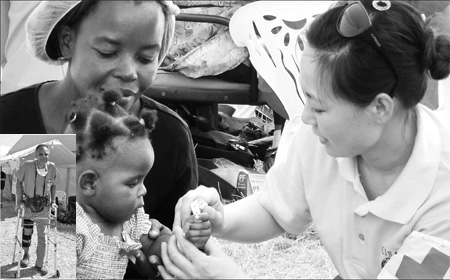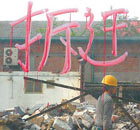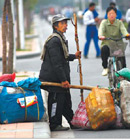Global General
Chinese medical teams on ground
By Chen Weihua and Huo Yongzhe (China Daily)
Updated: 2010-01-25 07:17
 |
Large Medium Small |
|
 Zhang Xuemei (R), a member of the China International Search and Rescue team, takes care of a Haitian baby at a field hospital in Port-au-Prince on Friday. Inset: Dr Ludner Confident, an anaesthetist from Florida who broke his leg a month ago, also works at the field hospital. [China Daily/Photos by Chen Weihua] |
PORT-AU-PRINCE: In a field hospital near the airport, Li Xianghui checked the wounds on a patient, while his colleague Hou Shike and several others rushed a patient on a stretcher to the tent next door.
Zhang Yanjun, meanwhile, was comforting a 2-month-old sick Haitian baby in her arms.
The OSOCC has described the international rescue mission this time as the longest and most effective in its history.
The rescue team leaving today, which has 15 Chinese doctors and nurses, will be replaced by another 40-person Chinese team with 30 medical staff, which is expected to arrive in Haiti tomorrow Beijing time.
In the last two days of their mission in Haiti, the Chinese rescue team still wanted to offer as much help as possible. On their way home to the base in the Sonapi industrial zone, they went by the Mais Gate park where 3,500 homeless Haitians made do with temporary shelters. They sprayed disinfectant to quarantine the area and distributed facial masks and quarantine leaflets in French.
A young man identified as Johnny and the communications director of the camp's committee said he welcomed the Chinese help. But he also said that his area had been largely looked over by the government. Clean water and food supplies were still far from adequate.
The Chinese medical team was returning to the same US hospital for the past several days, where medical professionals from many countries were offering their help and were busy treating many of the wounded in the earthquake.
In the last 10 days, the Chinese medical team has treated more than 2,500 patients and provided quarantine services to 10,000 locals, according to Huang Jianfa, head of the CISAR.
Huang, who has participated in all the rescue missions since CISAR's establishment in 2001, said the CISAR this time reacted the fastest in its history, arriving at 2 am on Jan 14 local time.
"The distance from home is also the longest and the number of the 50-member team the largest," Huang said.
Before finishing their work over the weekend, the Chinese medical team donated boxes of medicines and supplies to the US hospital.
Hospital without borders

Staffed by doctors from the University of Miami medical school, Project Medishare and other medical aid groups, the medical facility now accommodates about 150 patients, including a large paediatrician section.
On site, a Portuguese doctor checked the dressing on the injured while a French doctor inspected the case on the other side of the tent.
Patrick DeHeer, from Indiana and affiliated with Project Medishare, is a foot doctor who has been in Haiti 10 times. He had been taking care of the wounds and changing dressings for patients every day from 8:30 am to 5:30 pm, spending the night in a huge tent next door.
DeHeer, who has participated in similar missions in Iraq, Honduras and Ukraine, said he is mostly worried that people offering help are coming here for just one or two months before leaving the Haitians.
There is only one place in Haiti that could offer artificial limbs for amputated patients and that is far from enough, he said.
He explained his frequent visit to Haiti as part of efforts to share knowledge and teach others.
"I wish I could do it full time," he said.
Just meters from DeHeer, Ludner Confident, an anaesthetist from Florida, walked into the tent with a supporter. His right leg was broken after falling from a flight of stairs a month ago. But he flew to Haiti a few days ago to offer his help.
The 60-year-old doctor had lived in Haiti until he left for the US at the age of 25.
"I wish I could be here forever (to offer help)," Confident said.
Besides offering Haitians medical assistance, Confident also had an idea in his mind to build a golf resort in a peninsula only an hour's drive from Port-au-Prince.
"It is going to help the Haitian economy," said Confident, adding that he hopes some Chinese investors would be interested in his project.
Scene of pain
At the tent hospital, several wounded Haitians lay on lines of stretchers.
The screams of a number of children were heard from time to time, when the pain from changing dressings was unbearable.
Every few minutes, patients were rushed in and out of the site.
A girl suffering a life-threatening wound was taken care of by several doctors and nurses, who were trying hard to save her life.
Josh Hyman, a paediatrician, described a child's amputation case to an Israeli team medical officer, who agreed to take over the operation for the child.
Huang Jianfa of the CISAR highlighted the logistics of the situation.
"The US military is now in control of the logistics arrangement here and you also have to be part of the local healthcare system to get patients and send them to the right places," he said.












